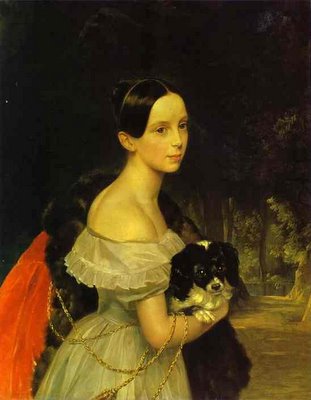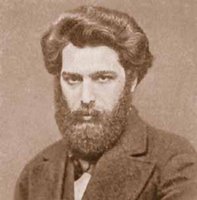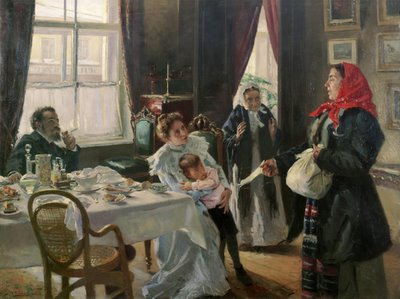24 décembre 2005
Albert Marquet (1875 - 1947)
Marquet Pierre Albert.
Né à Bordeaux, mort à Paris. Elève à l'Ecole des Arts-décoratifs, il se lia avec Matisse. Elève de Sérusier et de Gustave Moreau, il exposa ses oeuvres à partir de 1901. Séjourna en Algérie. Actif à Paris.
Né à Bordeaux, mort à Paris. Elève à l'Ecole des Arts-décoratifs, il se lia avec Matisse. Elève de Sérusier et de Gustave Moreau, il exposa ses oeuvres à partir de 1901. Séjourna en Algérie. Actif à Paris.
Karl Brulloff (1799 - 1852) / Карл Брюллов
je ne suis pas certain qu'il s'agisse de Karl.
Je recherche un tableau de 1836, exposé au musée de .....................
Il etait appelé par ses contemporains le grand Karl. Son chef d'oeuvre Le Dernier Jour de Pompeii (1830-1833), une creation colossale peinte en Italie en 1830-1833, fut une vraie reussite. Les critiques italiens ont comparé Brulloff aux plus grands artistes du passé, comme Rubens, Rembrandt, et Van Dyke. À l'âge de 33 Brulloff avait obtenu une reconnaissance européenne.
Je recherche un tableau de 1836, exposé au musée de .....................
Il etait appelé par ses contemporains le grand Karl. Son chef d'oeuvre Le Dernier Jour de Pompeii (1830-1833), une creation colossale peinte en Italie en 1830-1833, fut une vraie reussite. Les critiques italiens ont comparé Brulloff aux plus grands artistes du passé, comme Rubens, Rembrandt, et Van Dyke. À l'âge de 33 Brulloff avait obtenu une reconnaissance européenne.
Karl Brulloff (Brullo jusqu'en 1822, avant russification du nom de famille) est ne en 1799 a St. Petersburg dans une famille de peintres: son grand grand-père, son grand-père, son père et ses deux frères plus âgés Fedor et Alexander étaient des artistes. En 1809-1821, Karl etudia l'art a l'académie des arts de St. Petersburg. Un de ses premiers tableaux celebres Narcissus (1819), peint alors qu`il etudiait a l'académie, a ete execute en suivant les principes du Classicisme, qu`on lui avait enseigne. Brulloff a ete diplome de l`academie en recevant les honneurs et fut envoye avec son frere Alexander en Italie en tant que pensionnaires de la Societe pour la Pormotion des Artistes pour y etudier l`art
He spent in Italy 13 years, studying art of the ancient Italy, copying the antiques in the museums and making a lot of drawings in the streets of Rome. He painted portraits, both ceremonial and intimate ones, and created series of genre scenes of everyday Roman life. The most important of his genre works was Italian Midday (1827). In Italy Brulloff created over 120 portraits in various techniques. Among them are portraits of the Russian aristocracy, residing in Italy, as well as painters, sculptors, writers, etc., and also Italian statesmen and artists. Among the most notable are portraits of Grand Duchess Elena Pavlovna, Prince G. Gagarin, Countess Yu. Samoilova and her foster children, Princess Z. Volkonskaya, Bruloff's brother Alexander, A. Lvov, Architect K. A. Ton, Italian singers Juditta Pasta and Fanny Persiani-Tacinardi and many others. He also painted several self-portraits, some of them were commissioned by the Uffizi Gallery.
One of the requirements of the Society for the Promotion of Artists for its pensioners was to paint a big historical picture. In 1827, Brulloff visited the excavation site of Pompeii, a town destroyed and buried in hot lava during an eruption of Volcano Vesuvius on August 24, 79 A.D. Brulloff was deeply impressed when he saw the town, preserved under the layer of lava, where a life was suddenly stopped. Six years were to pass between the first conception and its materialization. After the first sketches have been done, Brulloff began studying the materials of the excavations and historical documents, such as the letters of Pliny the Younger, who was an eye-witness of the event. It is believed, that the son persuading his mother to come with him in the right part of the picture is Pliny with his mother. The picture The Last Day of Pompeii (1830-1833) was a huge success in Italy. It was also exhibited in Louvre, Paris.
In 1835, Brulloff returned to Russia. In the years that followed he painted mostly portraits. Among the best portraits of this period are those of Author Nestor Kukolnic, Count A. A. Perovsky (the Author Anton Pogorelsky) and his nephew future Poet and Playwright Alexey Tolstoy, Author A. N. Strugovshchikov, Princess Ye. P. Saltykova, Countess Yu. P. Samoylova.
In 1849, Brulloff had to come to Italy again for his deteriorating health, which was due to his unhappy marriage and his hard work on the paintings of St. Isaac's Cathedral in St. Petersburg, which he was unable to finish. He spent one year on Madeira, the climate of each was believed to be beneficial for the patients with heart diseases, and his last two years in Rome. He created several excellent works during these years, including portraits of members of Tittoni family, with whom he was very close. He died in Rome on June 23, 1852. Also see Brulloff's portrait by Vasily Tropinin.
Bibliogaphy:
He spent in Italy 13 years, studying art of the ancient Italy, copying the antiques in the museums and making a lot of drawings in the streets of Rome. He painted portraits, both ceremonial and intimate ones, and created series of genre scenes of everyday Roman life. The most important of his genre works was Italian Midday (1827). In Italy Brulloff created over 120 portraits in various techniques. Among them are portraits of the Russian aristocracy, residing in Italy, as well as painters, sculptors, writers, etc., and also Italian statesmen and artists. Among the most notable are portraits of Grand Duchess Elena Pavlovna, Prince G. Gagarin, Countess Yu. Samoilova and her foster children, Princess Z. Volkonskaya, Bruloff's brother Alexander, A. Lvov, Architect K. A. Ton, Italian singers Juditta Pasta and Fanny Persiani-Tacinardi and many others. He also painted several self-portraits, some of them were commissioned by the Uffizi Gallery.
One of the requirements of the Society for the Promotion of Artists for its pensioners was to paint a big historical picture. In 1827, Brulloff visited the excavation site of Pompeii, a town destroyed and buried in hot lava during an eruption of Volcano Vesuvius on August 24, 79 A.D. Brulloff was deeply impressed when he saw the town, preserved under the layer of lava, where a life was suddenly stopped. Six years were to pass between the first conception and its materialization. After the first sketches have been done, Brulloff began studying the materials of the excavations and historical documents, such as the letters of Pliny the Younger, who was an eye-witness of the event. It is believed, that the son persuading his mother to come with him in the right part of the picture is Pliny with his mother. The picture The Last Day of Pompeii (1830-1833) was a huge success in Italy. It was also exhibited in Louvre, Paris.
In 1835, Brulloff returned to Russia. In the years that followed he painted mostly portraits. Among the best portraits of this period are those of Author Nestor Kukolnic, Count A. A. Perovsky (the Author Anton Pogorelsky) and his nephew future Poet and Playwright Alexey Tolstoy, Author A. N. Strugovshchikov, Princess Ye. P. Saltykova, Countess Yu. P. Samoylova.
In 1849, Brulloff had to come to Italy again for his deteriorating health, which was due to his unhappy marriage and his hard work on the paintings of St. Isaac's Cathedral in St. Petersburg, which he was unable to finish. He spent one year on Madeira, the climate of each was believed to be beneficial for the patients with heart diseases, and his last two years in Rome. He created several excellent works during these years, including portraits of members of Tittoni family, with whom he was very close. He died in Rome on June 23, 1852. Also see Brulloff's portrait by Vasily Tropinin.
Bibliogaphy:
Karl Brulloff. by E. Atsarkina. Moscow. 1963. (in Russian)
Karl Brulloff in St. Petersburg. by A. Kornilova. Leningrad. 1976. (in Russian)
Russian Historical Painting. by M. Rakova. Moscow. Iskusstvo. 1979. (in Russian)
Brulloff. by G.Leontyeva. Russian Painters. Leningrad. 1986. (in Russian)
Karl Brulloff. Moscow. Izobrazitelnoe Iskusstvo. 1988. (in Russian)
Famous Russians in the 18th and 19th centuries. St. Petersburg. 1996. (in Russian).

Karl Brulloff. Portrait de U. M. Smirnova. 1837-1840
http://www.abcgallery.com/B/briullov/briullovbio.html
http://www.picture.art-catalog.ru/artist.php?id_artist=21
Arkhip Kuinji (1842 - 1910) / Куинджи Архип Иванович
 The Russian landscape painter Arkhip Ivanovich Kuinji was born in 1842 in the town of Mariupol on the Azov Sea in the South of Russia. Kuinji was of Greek descent – during the reign of Catherine II his ancestors, together with other Greek refugees, settled near the Azov Sea.
The Russian landscape painter Arkhip Ivanovich Kuinji was born in 1842 in the town of Mariupol on the Azov Sea in the South of Russia. Kuinji was of Greek descent – during the reign of Catherine II his ancestors, together with other Greek refugees, settled near the Azov Sea.Kuinji lacked a formal education, but his eminent gift helped him attain a notable success in art. He evidently was allowed to attend classes at the St. Petersburg Academy of Arts, had training in the workshop of the famous marine painter Ivan Aivazovsky, visited the classes of the Society of Art Lovers. In 1868, having passed exams in general education and special subjects at the Academy of Arts, Kuinji received a diploma of a freelance artist for his independent work. His earlier paintings Autumn Weather (1870), Lake Ladoga (1870) and On the Valaam Island (1873) brought him first recognition.
In 1873, Kuinji traveled around Germany, France, Switzerland and Austria and thoroughly studied the works of great masters. On his return, however, he creates works which were absolutely unlike those he had seen in European museums.
His Ukrainian Night (1876) opened a new romantic stage in his work. He used special light effects to paint nature and achieved such astonishing results, that people, who saw the picture for the first time at an exhibition, tried to check its back, if there was any special source of light. Exhibited at the Paris World Fair in 1878 The Ukranian Night attracted the attention of the eminent French critics.
Kuinji developed a new vision in his next painting A Birch Grove (1879). It is both realistic and conventionalized; it looks as a condensed essence of reality. In 1880, he completed Moonlit Night on Dnieper (1880). The picture was a great success. Kuinji became an idol of the public. But he was not understood by his colleagues who saw in his art only illusory color effects, did not support his romantic searching. Probably it was the reason of his withdrawal from all exhibitions and public arrangements. He worked hard in his studio, experimenting much, but only his close friends saw his works.
In 1894, he accepted an invitation to become a professor of the Academy. He was very fond of teaching and his students admired him. Among Kuinji’s pupils were several prominent artists such as N. Rerikh, K. Bogaevskiy, A. Rilov, V. Purvit and others. Unfortunately his career of a professor did not last long, he was dismissed for supporting students in their protests against authorities. But he continued to teach his students privately, and then paid for their trip around Europe. Later he presented the Academy with a big sum of money, the interest from which was to be used for awards to young painters. In 1909, he founded The Kuinji Society, an independent association of painters, to which he left all his pictures and property. The next year he died.
The other well-known works of Kuinji are A Birch Grove (1879), with one of its late versions A Birch Grove (1901), The North (1879), After a Rain (1879), Sea. The Crimea. (1898-1908), Elbrus in the Evening. (1898-1908), Sunset (1890-1895), Rainbow (1900-1905), Night Grazing (1905-1908).
Bibliography:
Kuinji and His School. Leningrad. 1987.
Kuinji. Russian Painters of the XIX century. by V. Minin. Moscow. 1990.
Paintings of the 18th-early 20th centuries from the Reserves of the Russian Museum. by K. Mikhailova and G. Smirnov. Leningrad. 1982.

"Ночь на Днепре"
Vladimir Makovski (1846-1920) / Владимир Маковский

Две матери. 1905-1906
http://www.ku.edu/~2yrruss/food_home_paintings/index.html

В приемной у доктора. 1870
http://rusgenre.narod.ru/gal2/1_1_10-9.htm
Ivan Shishkin (1832-1898) / Иван Шишкин
 The works of this outstanding artist enjoy vast popularity in Russia; the best of them have become the classics of Russian landscape painting. During 40 years of his artistic activity Ivan Shishkin produced hundreds of paintings, thousands of studies and drawings and a large number of engravings. For contemporaries, Shishkin’s personality embodied Russian nature itself; they called him “forest tzar”, “old pine tree”, and “lonely oak”.
The works of this outstanding artist enjoy vast popularity in Russia; the best of them have become the classics of Russian landscape painting. During 40 years of his artistic activity Ivan Shishkin produced hundreds of paintings, thousands of studies and drawings and a large number of engravings. For contemporaries, Shishkin’s personality embodied Russian nature itself; they called him “forest tzar”, “old pine tree”, and “lonely oak”.Ivan Ivanovich Shishkin was born into the family of a merchant. His father, a self-made and broad-minded man, after long hesitations, supported his son's desire to become an artist. In 1852-1856, Shishkin studied in the Moscow School of Painting and Sculpture, in 1856-1860, he continued his studies in St. Petersburg, in the Academy of Arts. He made rapid progress and got all the awards the Academy offered. Having received a Major Gold Medal for two pictures with the same name View of Valaam Island. Kukko. (1860) and an Academy grant for studies abroad, Shishkin spent 3 years (1862-1865) in Germany, Switzerland, Czech, France, Belgium and Holland. Gradually he got disappointed in his foreign teachers and European authorities in landscape painting. Now he felt free and independent and longed to return home, to Russia.
During his stay abroad Shishkin engaged in lithography and etching. His numerous pen drawings caught the eye of the Dusseldorf public and critics by their virtuoso hatching and filigree treatment of detail. In 1865, Shishkin painted his View near Dusseldorf for which he was awarded the title of Academician and which was shown at the 1867 World Fair in Paris.
In 1865, he returned to Russia and settled in St. Petersburg, where he joined the Itinerants’ Society of Traveling Exhibitions (Peredvizhniki). One of his first masterpieces Noon in the Neighbourhood of Moscow (1869) critics called “song of joy”. He always preferred to draw daytime scenes, full of sunlight and life. Pine Forest in Viatka Province (1872), Rye (1878), Path in a Forest (1880), Oaks (1887), Coniferous Forest. Sunny Day. (1895). His scrupulous reproduction of nature stood in sharp contrast to the academic canons of landscape painting. For his loving approach to detail some critics called his works colored pictures, which lack of life. But despite such attention to details Shishkin’s paintings do not fall apart, but give full and finished impression.
Shichkin had a troubled private life, twice he fell in love and married and twice his wives died. His sons also died. But never Shishkin allowed his sorrows appear on his canvases. His last work is Mast-Tree Grove (1898). He died in his studio at the easel with newly begun canvas.
Among the Russian landscape painters Shishkin was the staunchest and most consistent exponent of the materialistic aesthetics – to depict nature in all its pure, unadorned beauty. His role in Russian art did not lose its significance even in the years, which saw the appearance of splendid landscapes by Isaac Levitan, Valentin Serov and Constantin Korovin. Despite the fact that he espoused different aesthetic principles and advocated a different artistic system, Shishkin enjoyed an indisputable authority among young Russian painters of the late 19th century. The new generation did not fail to acknowledge him as a thoughtful and masterful portrayer of Russian nature.
Bibliography:
Shishkin by I. Shuvalova. Russian Painters of the XIX century. Moscow. 1990.
 "the kama river near yelabuga"
"the kama river near yelabuga"
Artistes orphelins....
Jusqu`a present, je n`ai pas reussi a retrouver leur trace.
Les avis de recherche sont lances...
Beeline
Boris Nhkolaev;
Tsaplim Valery "Still life with lobster";
Chemiakin Mihail;
Avetisian Arsen
====================
MTS-RUS
Shaposhnikov Alexandr
m.c. voielkovoil
(portrait)
borozdna - stromilova
neizv xoud
seredini koupalchitsa kopia
s kartini t.a. heffa
www.grw.ru/~nga
Les avis de recherche sont lances...
Beeline
Boris Nhkolaev;
Tsaplim Valery "Still life with lobster";
Chemiakin Mihail;
Avetisian Arsen
====================
MTS-RUS
Shaposhnikov Alexandr
m.c. voielkovoil
(portrait)
borozdna - stromilova
neizv xoud
seredini koupalchitsa kopia
s kartini t.a. heffa
www.grw.ru/~nga


